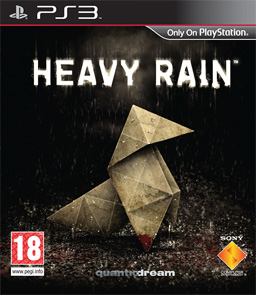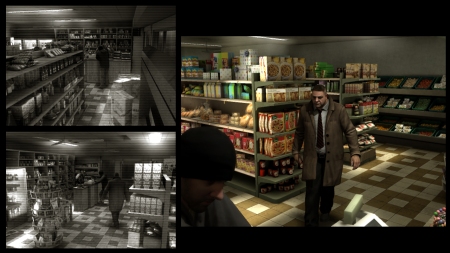GOONL!NE Review: Heavy Rain
Developer: Quantic Dream
Publisher: Sony
Also on: N/A (Playstation 3 exclusive)
Release Date: Friday February 26th 2010
Age Rating: BBFC: 15, PEGI: 18, ESRB: M
I’ll get it said right away at the start of the review, in case you may be worried by what’s about to follow. This will be a virtually spoiler free review, which I think is an absolute necessity for Heavy Rain. I can’t recall playing a more story-driven game than this in many years, and anyone who spoils the story before you experience it yourself should have their gaming thumbs severely injured in retribution. But experience the game you should. Even though we’re only in February, I’m prepared to stick my neck out and say that you’ll be hard pressed to find a more unique or more enjoyable PlayStation game this entire year.
Heavy Rain is a difficult game to categorise, as it doesn’t really fall into any traditional genre. The term “interactive movie” has been bandied around the games industry for years in reference to various titles, and never has the term been more apt than when used to describe Heavy Rain. While there are some sections which could easily be defined as action, they are still there to drive the story onwards towards its conclusion. It’s the story that is the main star of Heavy Rain, alongside the various characters you play, whom you will eventually form an emotional connection with, suffering and feeling just as they do during the course of the game.
The story of the game, and this is as much as I’ll reveal, sees you taking control of 4 different characters who are all involved one way or the other with the investigation into the serial killer known as the Origami Killer. There is Ethan Mars, an architect who experiences a traumatic change in his life that leads him towards depression. Norman Jayden is a young FBI Profiler brought in to assist the police in investigating and identifying the Origami Killer. Scott Shelby is a private investigator who has been hired by the families of the Origami Killer’s victims to look into the case. Finally, there is Madison Paige, an insomniac photojournalist who finds herself involved in the Origami Killer case and soon starts investigating it herself. Each character is different and interesting, and despite some character flaws here and there, you will still identify with them and grow attached to them, which helps draw you into the story.
As mentioned, the story is the star of Heavy Rain and it’s a story that can and will change depending on your actions. These changes will all have an impact on the story, in quite dramatic circumstances at times. Characters can die in Heavy Rain, and should it happen, you won’t be treated to a Game Over screen or be asked if you would like to replay the scene. Instead you’ll simply carry on with the story and be treated to one of the many different endings that are available for you to see.
The various decisions you will take in the game will vary between reactionary and moral, and you won’t always be instantly aware of the ramifications of your decisions. The reactionary decisions are pretty self explanatory, coming up in various action sequences and you may only get a second or so to choose a response. You won’t usually spend much time thinking about these decisions later as the action will usually continue onwards straight after your choice. The moral decisions are where the game can really put you through a mix of emotions. As you develop a connection with the characters you’re controlling, the decisions they face will put you in two minds as to what option to take. It’s not usually anything so clear cut as right or wrong either.
There are several decisions in the game which will affect your character and the response isn’t a black and white case of right or wrong, but a morally ambiguous situation that will really cause you to think hard about your decision. I can remember one clear occasion when I actually had to pause the game for a moment to think through my decision. Logic was telling me one choice was the clear one, but my morals were pulling me in a different direction. I had identified with the character and I could feel what they were going through, and I ended up picking the choice that I feel I would make if I were ever in the same situation. Choices like these, scenarios that really make you question what you are doing are part of the factors that set Heavy Rain apart from virtually every other game on the market today.
As good as the story is however, it does start off a little slowly, and you could be forgiven for wondering what all the hype is about during your first hour of gameplay. Seemingly designed as an introduction to the controls as well as some of the characters, the first section of the game is perhaps a little too mundane as you control your character through a start to his normal day, showering and getting dressed. As you progress further into the game however, you realise that this slow intro is necessary, not only to get you comfortable with the controls but to set the mood for the rest of the game.
One of the reasons the game is so immersive is due to the control methods used in the game. Rather than using the left thumbstick to move around, you need to hold R2 to walk forward, with the left thumbstick used for turning your character in different directions. If you want to interact with something, such as opening a drawer, knocking on a door or starting a car, you will be given an on-screen direction rather than always having to press a particular button. The directions usually involve moving the right thumbstick in a given direction, or performing a quarter circle rotation (much like performing a Fireball in Street Fighter), and will often incorporate the shoulder buttons and face buttons as well. Depending on the situation, you may need to do the action as quickly as possible, or slow and steady. You will often be required to hold down one or more buttons until the action has been completed. The control method may sound a little strange but it becomes second nature after a while, and really helps immerse you in the gameplay, especially in the more tense sequences where your own skill with the controller can mean the difference between success and failure of a particular chapter.
The action sequences in the game, of which there are several, are made up of a series of Quick Time Events. While this may initially put some people off, it’s handled in a much better way than in any game I’ve ever played. Much like interacting with objects, during these sequences, different instructions will pop up on screen, telling you to press a certain button, or to shake the SIXAXIS controller, or to move the right thumbstick in a certain direction. If you miss any particular instruction, that doesn’t mean that you fail the entire sequence, but it will have a consequence. If you’re in a fight, missing a button press may mean taking a right hook instead of blocking it. You could be running away from someone, and instead of leaping gracefully over obstacles, you may trip and stumble over them. These sequences are all handled in such a way that you really become involved in them. If you’re fighting and you see your opponent grab a weapon, you’ll feel the adrenaline pump as you know an incorrect button press could lead to an unfortunate meeting with that weapon. It’s as involving as any QTE system could be, and it’s used exceptionally well in Heavy Rain, breaking up the story segments, but all still making perfect sense in the context of the game.
The game benefits from having some exceptional graphics to go along with the wonderful story. Each of the characters in the game has some of the best facial expressions around, really helping to show the emotions they’re experiencing in the various scenes in the game. From anger to love, hope to despair, each emotion is evident on the faces of the various protagonists as they make their way through the game. The animation of the characters is equally as good for the most part, though there are a few sections where the animations look a little stiff. The audio in the game is also of very high quality. The vocal work is generally very well done, with a few poor lines here and there, but the ambient sounds and effects in the game more than make up for it. The atmosphere throughout the game is a dark one, and the music and sounds fit in perfectly.
Unfortunately Heavy Rain isn’t a perfect game, despite the high praise I’ve lavished on it already. Some of the choices you will make earlier in the story don’t have a huge impact on the later parts of the game, and it’s only when you reach the middle part of the game that you start to face the more difficult decisions. This spoils the replay value somewhat, though the game does benefit from having a level select, where you can jump in and carry on the story from whatever chapter you choose. There is also one rather large plot hole which is never explained at all that will certainly have you scratching your head about. It’s entirely possible it will be dealt with in one of the future pieces of downloadable content, but I really think it should be addressed in the game. Red herrings in a story are fine, but this plot hole is so big you could park a truck in it when it’s never explained or touched on in the latter part of the game. Perhaps they’ve just left it unexplained so you can draw your own conclusions.
Despite the flaws, Heavy Rain is a game that every PlayStation owner should play. It’s such a unique experience, from the control method to the way the game is so story driven, that as a gamer you owe it to yourself to try it. Unless you’ve experienced a Quantic Dreams game before, such as Fahrenheit/Indigo Prophecy, you will never have played a game quite like it. It’s not a game that everyone will love, it will be just too story driven for them, or they won’t like the Quick Time Event action sequences. If you’re willing to give the game a chance, to look beyond the initially clumsy controls, to persevere through the slow start to the game, you’ll find one of the best console games of this generation.
Final thoughts: Quantic Dreams have created a masterpiece of interactive storytelling that every PlayStation owner should experience. It won’t be to everyone’s tastes, especially with the slow start, but it’s a unique experience and will hopefully pave the way for more games of this type to be made.
Gameplay – 9: A great mixture of story-driven scenes and action sequences. The knowledge that your decisions have a real impact on the story can be incredibly thought-provoking.
Graphics – 9: Stunning graphics that at times are some of the best you’ll see. Unfortunately let down by the occasional stiff animation here and there.
Sound – 9: Very solid voice acting and excellent effects contribute to the dark atmosphere that is present throughout the entire game.
Presentation – 10: Quite simply stunning, the whole game is beautifully put together, with wonderful artwork and direction tying in with the audio and visual side of the game.
Overall – 9: A breath of fresh air in a time when there is a multitude of sequels and cookie-cutter games on the market. More companies should be willing to take the chance and do something different, as the results can be breathtaking. Very highly recommended.






